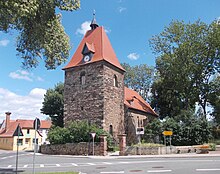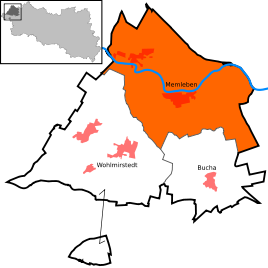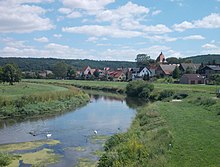Memleben
|
Memleben
Community Imperial Palace
Coordinates: 51 ° 15 ′ 53 ″ N , 11 ° 29 ′ 32 ″ E
|
|
|---|---|
| Height : | 120 m above sea level NN |
| Area : | 16.76 km² |
| Residents : | 690 (Dec. 31, 2007) |
| Population density : | 41 inhabitants / km² |
| Incorporation : | July 1, 2009 |
| Postal code : | 06642 |
| Area code : | 034672 |
|
Location of Memleben in Kaiserpfalz
|
|
Memleben is a district of the Kaiserpfalz municipality in the Burgenland district in Saxony-Anhalt .
geography
The place is in the western Burgenland district not far from Nebra on the Unstrut . It is part of the community of An der Finne , based in Bad Bibra .
history
Settlement of the place in prehistory and early history
As part of the research into the Nebra finds, the Friedrich Schiller University Jena dug an Iron Age storage pit with the skeleton of a goat on the Wendelstein . Other finds indicate that the site was already used in the late Bronze Age .
Memleben in the Middle Ages
"Mimilebo", "Mimileba" or "Mimileiba" refers to the genetic makeup of a Mimo or Mimi.
The place was mentioned as Mimelebo in a document as early as 780 in a list of the goods of the Hersfeld Monastery, built by Archbishop Lullus († 786) of Mainz .
In a register of the tithe of the Hersfeld monastery , which was created between 881 and 899, Meginrichesdorpf in Friesenfeld is mentioned as a place with a compulsory tithe . Hermann Großler brought this place in connection with Memleben or the later deserted area Weningenmemleben on the left bank of the Unstrut. Mimileba is also mentioned at the same time .
Its importance grew under the reign of the first Saxon king of the East Franconian Empire, Heinrich I. Heinrich I died here on July 2, 936, presumably after a stroke. His son Otto I also stayed frequently in Memleben, where he issued documents several times. The place thus gained importance throughout the empire. Otto I also died in Memleben on May 7, 973. According to Widukind von Corvey , his entrails were buried in a Marienkirche in Memleben. The son of Otto the Great, Otto II , founded a Benedictine monastery in honor of his father before or at the beginning of 979 , which he supported with numerous donations. Memleben achieved the greatest importance under Otto III.
Memleben's heyday ended in 1015. Heinrich II , the successor of Otto III., On November 16, 1002, the year he took office, had confirmed to Abbot Reinhold the privileges guaranteed by his predecessors, such as free election of abbot and bailiff, and the monastery even with the three The imperial abbeys of Fulda , Corvey and Reichenau were legally equated, but 13 years later he revised this decision and made Memleben monastery again subordinate to Hersfeld monastery.
Modern times
In 1525 the monastery was plundered by rebellious peasants, and in 1548 it was finally abolished after increasing decline due to the Reformation . In 1551 the associated goods were confiscated by the Saxon Elector and given to the Pforta State School , which had just been newly founded. She kept it until the end of World War II . Memleben belonged to the Electoral Saxon Office of Pforta as an exclave from 1551 until 1815 .
In 1641 the French looted Memleben, killing 164 people. In 1722 lightning destroyed the roof of the old monastery church. Years later, the church began to be demolished. Today the remains of this church can still be seen and are well worth a visit. In 1763, the site was almost completely destroyed by fire, and in keeping with the appearance of the site, most of the old buildings have been lost. By the resolutions of the Vienna Congress Memleben 1815 came to Prussia in 1816 the district Eckartsberga in the administrative district of Merseburg of the Province of Saxony assigned to which he belonged until 1944th In 1936, Memleben celebrated its thousand-year history under National Socialist rule in memory of the 1000th anniversary of the death of Heinrich I.
After the Second World War, a large state-owned estate (VEG) was founded in Memleben , which also acquired ownership of the former monastery. A lot has been structurally changed, new barns, stables, apartments and offices were created. During the time of the GDR , VEG Memleben intensively cultivated seeds (grain) in the fields of the region , there were huge pig fattening systems and cowsheds in Memleben. The population grew to over 1000 inhabitants during this time. Every year from 1970 until the fall of the Wall , Memleben organized the cooperation festival, which is known far beyond the regional borders, two weeks after Whitsun . In 1986 Memleben celebrated its 1200th anniversary of the first documentary mention.
In 1991 the place applied for the seat of the federal capital and justified its application with the extraordinarily significant history of the place. With the establishment of the Romanesque Road, the first funds for the rescue of the monastery complex in Memleben were made available, thus laying the foundation for today's development.
On July 1, 2009, Memleben was incorporated into the new Kaiserpfalz community and the An der Finne community .
politics
mayor
After the fall of the Wall, Uwe Hartung was the full-time mayor from 1989 to 1994. The last (honorary) mayor was from July 1, 1994 to June 30, 2009 Dr. Helmut Reich († May 24, 2012).
Attractions
Monastery and Imperial Palace
Although no structural remains of the old Palatinate have been found so far, some parts of the wall still stand from the monumental church of the 10th century, such as the southwest transept, the southern nave wall and a not inconsiderable part of the southwest crossing pillar. It is a double choir of immense dimensions (length 82 meters, width 39.5 meters). The floor plan has been archaeologically secured and is presented by paving.
Construction of a new, smaller monastery complex began in the 12th century. Of the monastery church, which was completed in the first half of the 13th century, the late Romanesque crypt is particularly noteworthy. It is the only room in the monastery that has been preserved in its original state. The early Gothic arcades of the central nave of the church shape the romantic character of the entire complex. Life-size silhouettes can be seen on the pillars in the nave.
The entire complex is now used as the "Museum Kloster und Kaiserpfalz Memleben". A modeled, medieval monastery garden as well as numerous exhibition areas that fill the former cloister building give the visitor a picture of the importance of the place Memleben over the building history of the monastery up to the Benedictine monastery life and the medieval book production in a so-called scriptorium. Guided tours, educational museum events and cultural events enliven the former Benedictine monastery.
The municipality of Memleben was awarded a special prize for the further development of the Museum Kloster und Kaiserpfalz Memleben by the Minister of Economics of Saxony-Anhalt in 2008 as part of the Romanesque Prize. In order to justify the award, it was said that the commitment of the community, administrative community and support association had created two permanent exhibitions, a monastery shop and the educational museum "Living Monastery".
In October 2008, the Memleben Monastery and Imperial Palatinate Foundation was established by the then Memleben community. The foundation is headed by the mayor of the community of An der Finne . Since then, it has implemented numerous construction projects and on March 15, 2012 opened a new monastery gate as a new entrance and information area.
More Attractions

The church of St. Martin also has its origins in the Middle Ages and is currently being renovated so that it can continue to be used by the parish.
For a number of years there has been an adventure park with numerous native and exotic animals in the village.
On the Wendelstein there is a castle ruin that originally dates back to the 14th century. The remains of a Romanesque chapel have been preserved from the oldest part of the castle . The stepped moat and the casemates are impressive .
Individual evidence
- ^ Karlheinz Blaschke , Uwe Ulrich Jäschke : Kursächsischer Ämteratlas , Leipzig 2009, ISBN 978-3-937386-14-0 ; P. 34f.
- ↑ Places of the Prussian district Eckartsberga in the municipality register 1900
- ↑ StBA: Area changes from January 2nd to December 31st, 2009
literature
- Helge Wittmann (Ed.): Memleben: Königspfalz - Reichskloster - Probstei. Imhof Petersberg 2001, ISBN 3-932526-92-9
- Fritz Kühnlenz: Cities and castles on the Unstrut. Greifenverlag, 1st edition 1992, ISBN 3-7352-0293-4 or special binding - Verlagshaus Thüringen 1999, ISBN 3-89683-121-6
Web links
- www.kloster-memleben.de
- Link catalog on the topic of Memleben at curlie.org (formerly DMOZ )
- http://www.blaues-band.de/unstrut/memleben.htm






